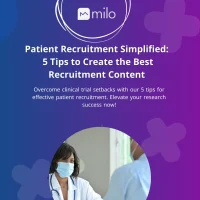As surprising as this might be, problems with patient recruitment are often one of the main reasons for failures in clinical trials. A poorly advertised clinical trial might not reach enough people to meet the recruitment rate goal, and badly written information documents and consent forms are unlikely to encourage people to enroll. Challenges in recruitment can prevent a trial from even starting.
The good news is that, with some practice and expert guidance, it is possible to make significant improvements to your company’s recruitment process, without exceeding budgets or deadlines. Read this article to learn our top five tips to create good recruitment content and avoid one more obstacle to highly efficient clinical trials.
A Challenging Process
It is not uncommon for manufacturers to have to extend the timeline of a trial or even abort it because the recruitment goal was not met. Simple as it might seem, recruiting participants requires some expertise in advertising and good communication.
Ensuring that information about the trial reaches as many relevant people as possible is not an easy task. Moreover, once they are acquainted with the research, poorly written information content might prevent them from getting interested in joining. In a third level of challenge, participants who may be considering enrolling can get discouraged by untransparent and complicated consent process.
Choosing to participate in a clinical trial is a big decision. Patients consider many factors before enrolling, from potential risks and benefits to the level of disturbance in their daily routines. This decision is harder to make when they do not have enough information to evaluate, which shows how important it is to have a well-written, comprehensive trial information content.
Aside from reaching recruitment goal rates, having a diverse group of participants is another concern of researchers that often becomes a challenge. Even when having enough interested people is not a problem, quality of data may still be affected if this group does not reflect well the patient population that the drug or medical device is intended to.
So, as you can see, recruiting patients can be a challenge in many ways. However, there are some simple strategies that can help avoid many of these hurdles and make the process less intimidating. Below, we suggest five approaches to creating the best patient recruitment content.

#1 Make the Most of Digital Resources
Social media and other online channels are already a part of most people’s lives, so why not benefit from this presence to reach a wider audience and increase enrollment rates? Nowadays, people are more likely to find out about something and be interested in it if they see it on their Instagram feed, rather than reading about it in the newspaper or listening to a radio ad.
Consider the specific characteristics of digital content while creating your recruitment materials. Remember that social media is highly dependent on graphics and images and that lengthy texts might not be a good idea. The goal is to reach people with content that is informative while also being interesting and compelling to the right patients.
#2 Practice Inclusive Writing
This strategy is especially important when it comes to avoiding the diversity challenge. Inclusive writing means creating content that is interesting to and can be effortlessly read by many different people. Some tips to do this are:
- Write short sentences and paragraphs
- Ensure you are using the right terms to address specific conditions
- Consider the age and geographic location of the target group to choose vocabulary that resonates with them
- Avoid jargons and acronyms
- Personalize content by including information that is useful and interesting for that particular group
#3 Design Accessible Forms
People often underestimate the difference a good design can make. In the case of recruitment material and consent forms, a detail in the design can be what differentiates compelling, interesting content from less readable, unexciting texts which will not encourage enrollment.
Special design is also necessary to reach patients with visual, hearing and cognitive disabilities. Not considering these people’s needs in the design reduces significantly the diversity of any participant pool. With digital content and forms, it is a lot easier to adapt the same content to different needs, so there is no reason to neglect the design and have your recruitment goals impacted.
#4 Promote Transparency
Transparency is the basis of informed consent, so it should be a natural goal of anyone recruiting patients for a clinical trial. However, writing content that is accurate, clear and honest is also the way to gain people’s trust from the moment they first interact with the material.
If people see an ad that is ambiguous, difficult to understand or too vague, chances are that they will ignore it as irrelevant or worse, disregard it as suspicious or untrustworthy. All your recruiting content should reflect your team’s willingness to be as transparent as possible about the trial’s possible outcomes, risks and benefits, using language that is precise, clear, and accurate.
#5 Keep the Conversation Open
Recruitment content should not be a one-way speech. It should be made clear that the team is available any time to answer questions about the trial and guide patients through the consent process. People are a lot more likely to respond (positively) to something that invites them to give their input and share their concerns freely.
A simple way to do that is to display contact information clearly in a way that gets people’s attention. Make good use of the interactive features of eConsent forms, facilitating direct communication between the research team and participants.
Summary
- Problems with patient recruitment are often one of the main reasons for failures in clinical trials
- Recruiting participants requires some expertise in advertising and good communication
- Patients consider many factors before enrolling, from potential risks and benefits to the level of disturbance in their daily routines
- Having a diverse group of participants is another concern of researchers that often becomes a challenge
- Five tips to creating the best patient recruitment content are making the most of digital resources; practicing inclusive writing; designing accessible forms; promoting transparency and keeping the conversation open







